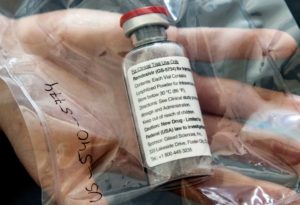Antivirals in the Time of Coronavirus
An Evaluation of Remdesivir and Hydroxychloroquine
Many years ago, efforts to contain HIV resulted in the first widespread successful use of antiviral drugs, including deoxynucleotide analogs such as AZT, able to terminate reverse transcription of viral RNA. The current coronavirus pandemic has spurred extensive efforts to identify effective and safe anti-SARS-CoV-2 drugs. Recent reports have excited interest in Gilead’s remdesivir. Remdesivir’s activity is somewhat analogous to AZT, in that it is a nucleotide analog, but it has a 3-OH group and is not therefore a classical RNA chain terminator. Nevertheless, an analysis in vitro shows that it causes termination of transcription of viral RNA by RNA-dependent RNA polymerase RDRP 3 residues after its incorporation. There are some excellent reports characterizing in vitro activity of remdesivir against SARS-CoV-2 RDRP (1-4).
Remdesivir use has some potential issues. It is not orally bioavailable and must be infused. Treatment duration is a question still to be answered. Cost could be an issue. The SARS-CoV-2 has a 5’-3’ exonuclease which potentially could remove inappropriate nucleotide analogs, but at least in vitro with purified RDRP, this does not appear to happen.

Remdesivir (credit: Ulrich Perrey / Pool via Reuters)
The big question is of course is what is its therapeutic value? The recent excitement has come from two reports. One, in the New England Journal of Medicine, reported results from an uncontrolled compassionate use trial(5). Of 53 patients, 68% showed clinical improvement. More dramatic results were reported during a faculty video discussion at University of Chicago. Out of 113 patients with severe disease treated with remdesivir, most were successfully discharged and only two died. Again, however, this amounts to an uncontrolled trial, although the results are quite encouraging. These results represent preliminary findings from a trial sponsored by Gilead with 2,400 severe disease cases and 1600 moderate disease cases which is comparing treatments of five days duration with those of 10 days duration, so there is no true control group. However, further results are eagerly anticipated.
It appears that at the very least, targeting RDRP will be a fruitful approach. The development of an orally bioavailable version of remdesivir seems important. Since the structure of the RDRP is known, design of more powerful inhibitors should be possible. Finally, processing of the viral polyproteins into their functional forms requires a viral protease, called 3CL, for which it should be possible to design inhibitors. Protease inhibitors have proven highly effective in the cases of HIV and hepatitis C virus and could prove a useful alternative or additional target against SARS-CoV-2. Candidates for 3CL inhibitor lead compounds have already been identified(6).
Hydroxychloroquine has also received some attention, although its benefits are not yet clear, and it has some risky cardiac side effects. Although hydroxychloroquine has some activity in vitro against SAR-CoV-2 as well as other coronaviruses, it does not appear to have anti-coronaviral activity in infected animals. There have been several small studies reported in Covid19 patients. One in France, published online, showed a reduction in viral RNA in patients treated with hydroxychloroquine ± azithromycin. However, this was not a randomized trial, had small numbers of patients, and had a number of methodological flaws. The other study, a controlled multicenter trial in China with 75 patients treated and 75 in the control arm. No effect was noted on viral RNA levels, but some clinical benefit was observed. A trial in Brazil was halted due to cardiotoxocity. The effects of hydroxychloroquine have been attributed to alteration of the endosomal compartment, affecting viral entry; alteration of glycosylation of ACE2, the spike protein receptor, reducing affinity; and immunomodulation, lowering an overly active inflammatory response. Its usefulness in Covid19 thus remains unsettled. More recently, a larger but still non-controlled study was reported by the Veterans Administration with 368 patients (hydroxychloroquine alone, n=97; hydroxychloroquine plus azithromycin, n=113; and no hydroxychloroquine, n=158). No benefit was observed; deaths were higher in the hydroxychloroquine group. The benefit/risk ratio of hydroxychloroquine is still unclear. Novartis is initiating a large clinical trial in the US to determine efficacy that could help answer this question.
- Y. Gao et al., Structure of the RNA-dependent RNA polymerase from COVID-19 virus. Science, (2020).
- C. J. Gordon et al., Remdesivir is a direct-acting antiviral that inhibits RNA-dependent RNA polymerase from severe acute respiratory syndrome coronavirus 2 with high potency. J Biol Chem, (2020).
- A. Shannon et al., Remdesivir and SARS-CoV-2: structural requirements at both nsp12 RdRp and nsp14 Exonuclease active-sites. Antiviral Res, 104793 (2020).
- T. P. Sheahan et al., An orally bioavailable broad-spectrum antiviral inhibits SARS-CoV-2 in human airway epithelial cell cultures and multiple coronaviruses in mice. Sci Transl Med, (2020).
- J. Grein et al., Compassionate Use of Remdesivir for Patients with Severe Covid-19. N Engl J Med, (2020).
- Z. Jin et al., Structure of M(pro) from COVID-19 virus and discovery of its inhibitors. Nature, (2020).
